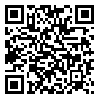Volume 76, Issue 10 (January 2019)
Tehran Univ Med J 2019, 76(10): 678-685 |
Back to browse issues page
Download citation:
BibTeX | RIS | EndNote | Medlars | ProCite | Reference Manager | RefWorks
Send citation to:



BibTeX | RIS | EndNote | Medlars | ProCite | Reference Manager | RefWorks
Send citation to:
Koochakpoor G, Hosseini-Esfahani F, Daneshpour M S, Mirmiran P, Azizi F. Food group interactions with genetic poplymorphisms of CCND2, ZNT8 and MC4R in relation to risk of metabolic syndrome and its components. Tehran Univ Med J 2019; 76 (10) :678-685
URL: http://tumj.tums.ac.ir/article-1-9280-en.html
URL: http://tumj.tums.ac.ir/article-1-9280-en.html
Glareh Koochakpoor1 
 , Firoozeh Hosseini-Esfahani2
, Firoozeh Hosseini-Esfahani2 
 , Maryam Sadat Daneshpour3
, Maryam Sadat Daneshpour3 
 , Parvin Mirmiran *
, Parvin Mirmiran * 
 4, Fereidoun Azizi5
4, Fereidoun Azizi5 


 , Firoozeh Hosseini-Esfahani2
, Firoozeh Hosseini-Esfahani2 
 , Maryam Sadat Daneshpour3
, Maryam Sadat Daneshpour3 
 , Parvin Mirmiran *
, Parvin Mirmiran * 
 4, Fereidoun Azizi5
4, Fereidoun Azizi5 

1- Department of Nutrition and Food Sciences, Maragheh University of Medical Sciences, Maragheh, Iran.
2- Nutrition and Endocrine Research Centre, Research Institute for Endocrine Sciences, Shahid Beheshti University of Medical Sciences, Tehran, Iran.
3- Cellular Molecular and Endocrine Research Centre, Research Institute for Endocrine Sciences, Shahid Beheshti University of Medical Sciences, Tehran, Iran.
4- Nutrition and Endocrine Research Centre, Research Institute for Endocrine Sciences, Shahid Beheshti University of Medical Sciences, Tehran, Iran. ,mirmiran@endocrine.ac.ir
5- Endocrine Research Centre, Research Institute for Endocrine Sciences, Shahid Beheshti University of Medical Sciences, Tehran, Iran.
2- Nutrition and Endocrine Research Centre, Research Institute for Endocrine Sciences, Shahid Beheshti University of Medical Sciences, Tehran, Iran.
3- Cellular Molecular and Endocrine Research Centre, Research Institute for Endocrine Sciences, Shahid Beheshti University of Medical Sciences, Tehran, Iran.
4- Nutrition and Endocrine Research Centre, Research Institute for Endocrine Sciences, Shahid Beheshti University of Medical Sciences, Tehran, Iran. ,
5- Endocrine Research Centre, Research Institute for Endocrine Sciences, Shahid Beheshti University of Medical Sciences, Tehran, Iran.
Abstract: (2836 Views)
Background: There are contradictions in the role of genetic variations and food group intake on metabolic syndrome (MetS). This study was aimed at examining the interaction between food groups and CCND2 rs11063069, ZNT8 rs13266634 and MC4R rs12970134 polymorphisms, regarding MetS and its components.
Methods: In this matched nested case-control study (2006-2014), the data of 1634 (817 pairs) case and controls were selected among participants of the Tehran Lipid and Glucose Study (TLGS). The cases and controls were matched by age, sex and number of follow-up years. Dietary intakes were assessed using a valid and reliable food frequency questionnaire. Polymorphisms were genotyped.
Results: A significant interaction was observed between rs12970134 and green vegetable, read meat, and soft drink, in relation to the risk of low high density lipoprotein cholesterol (HDL-C), high triglyceride (TG) and high fasting blood glucose (FBG), respectively (P<0.05). The consumption of vegetables altered the effect of rs11063069 on MetS. Among G allele carriers, being in the highest quartiles of vegetables intake had a decrease risk of MetS, compared to those in the lowest quartile (P=0.007), but this trend was not observed in AA genotype carrier. There was also a significant interaction between rs13266634 and salty snack and fish intakes, in relation to the risk of abdominal obesity (P<0.05). Increasing salty meals by CT+TT genotypes carriers increased the odds ratio of abdominal obesity, while in the CC genotype, this increase was not observed. A significant interaction was also observed between rs11063069 with other vegetables, red-yellow vegetable and fruit intake respectively, regarding the risk of high FBG, low HDL-C and high blood pressure (P<0.05).
Conclusion: The present study demonstrates the interaction between food groups and MC4R, ZNT8 and CCND2 polymorphisms. To reduce the risk of MetS, high risk allele carriers of rs12970134 must avoid meat consumption, while in high risk allele carriers of rs11063069 and rs13266634, vegetables and fish should be consumed.
Methods: In this matched nested case-control study (2006-2014), the data of 1634 (817 pairs) case and controls were selected among participants of the Tehran Lipid and Glucose Study (TLGS). The cases and controls were matched by age, sex and number of follow-up years. Dietary intakes were assessed using a valid and reliable food frequency questionnaire. Polymorphisms were genotyped.
Results: A significant interaction was observed between rs12970134 and green vegetable, read meat, and soft drink, in relation to the risk of low high density lipoprotein cholesterol (HDL-C), high triglyceride (TG) and high fasting blood glucose (FBG), respectively (P<0.05). The consumption of vegetables altered the effect of rs11063069 on MetS. Among G allele carriers, being in the highest quartiles of vegetables intake had a decrease risk of MetS, compared to those in the lowest quartile (P=0.007), but this trend was not observed in AA genotype carrier. There was also a significant interaction between rs13266634 and salty snack and fish intakes, in relation to the risk of abdominal obesity (P<0.05). Increasing salty meals by CT+TT genotypes carriers increased the odds ratio of abdominal obesity, while in the CC genotype, this increase was not observed. A significant interaction was also observed between rs11063069 with other vegetables, red-yellow vegetable and fruit intake respectively, regarding the risk of high FBG, low HDL-C and high blood pressure (P<0.05).
Conclusion: The present study demonstrates the interaction between food groups and MC4R, ZNT8 and CCND2 polymorphisms. To reduce the risk of MetS, high risk allele carriers of rs12970134 must avoid meat consumption, while in high risk allele carriers of rs11063069 and rs13266634, vegetables and fish should be consumed.
Type of Study: Original Article |
Send email to the article author
| Rights and permissions | |
 |
This work is licensed under a Creative Commons Attribution-NonCommercial 4.0 International License. |



